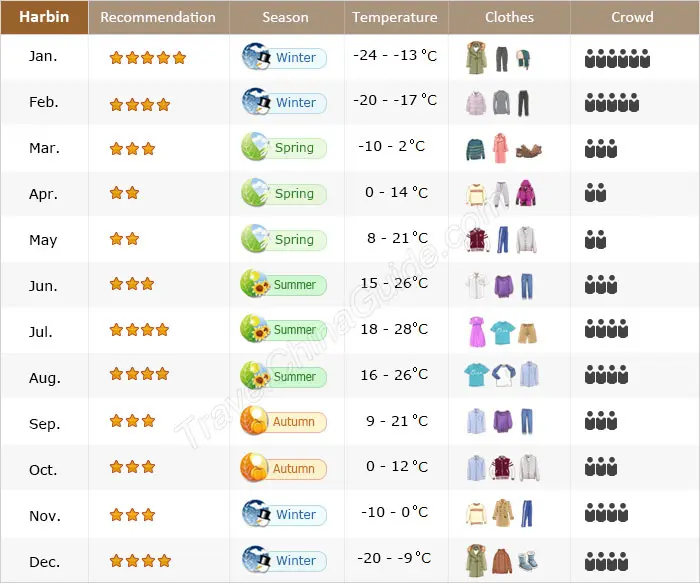Best Time to Visit Harbin
 |
Peak Season: July - August & November - February
During the peak season, especially December to February, attractions, hotels, transportation and restaurants may cost more than usual. However, tourists are able to enjoy stunning scenery, diversified activities and good service. Since the summer of Harbin is cool and has lots of rainy days, tourists should bring a thin jacket and umbrella. Likewise, precautions should be taken against the chilly and dry weather in winter. A woolen hat, scarf, gloves and hand cream are necessary.
Slack Season: March - June & September - October
If you are more interested in Harbin’s history and culture, it will be more cost effective to visit during the slack season. Cheaper tickets and less crowded attractions will give you a high quality travel experience. By the way, during this period, one should be prepared for a sudden increase or decrease of temperature, and bring enough clothes in order not to catch a cold.
Times to Avoid Travel
Overseas tourists should avoid travelling during the public holidays in China, so as to avoid crowds of people and increased costs. The two longest holidays, each with seven days off, are the Chinese New Year in late January or early February, and the National Day holiday from Oct. 1st to 7th. Special attention should be paid to the former, for it coincides with the best time to visit Harbin mentioned above.![]() See more about the National Holidays in China
See more about the National Holidays in China
Travel to Harbin in Four Seasons
Spring: March to May
In spring Harbin has some foggy days and sudden increases of temperature with occasional downturns.
Average temperature: -1-14℃ (30-57℉)
Clothes: thick jacket, windbreaker, sweater, padded trousers
As the weather turns warm, spring is the best time to go to Harbin Forest Park to feel nature’s revival. In April, the fragrance of apricot, peach and plum blossoms is very refreshing. In May, the lilacs, azaleas and tulips are sure to please your eyes. Tourists may also visit the Siberian Tiger Park and get close to energetic animals. On the sightseeing bus, one may buy live chicken to feed the white tiger, lion, puma and wolf. Historical sites, of course, should not be forgotten. Jile Temple, the largest Buddhist temple in Harbin, holds many temple fairs in May, and tourists can burn incense to pray for good luck. Lastly, the landmark of Harbin, St. Sophia Cathedral, is a must. From the outside, tourists will be impressed by its giant domes representative of the Byzantine style.
Summer: June to August
Harbin’s summer is very cool and has more rainy days than other seasons.
Average temperature: 16-27℃ (60-80℉)
Clothes: long dress, short-sleeve T-shirt, blouse, hoodie, thin jacket
June to August is undoubtedly the Harbin best time to visit summer resorts, and the best develped one is the Sun Island Scenic Area. Every tourist will feel cool upon seeing the beautiful lakes and waterfalls. Take a walk through lush vegetation and you will come across many exotic Russian buildings. Moreover, fishing, swimming or picnicking are all allowed here. Speaking of summer resorts in Harbin, one may consider visiting the Jinhewan Wetland Park, Binjiang Wetland Park or Baiyupao Wetland Park. We recommend that tourists with children go to the Harbin Polarland to view polar bears, penguins, sea lions, rays, etc. and watch the white whale performance. In the evening, take the peaceful Songhua River cruise and enjoy the night view of both banks.
Autumn: September to October
Harbin’s autumn is generally moderate and appropriate for outdoor activities.
Average temperature: 5-17℃ (41-63℉)
Clothes: jacket, cardigan, hoodie, coat, sweatpants
Though Harbin’s autumn is short, its natural landscape is as good as any other city. Jinlong Mountain and Fenghuang Mountain are nice places to appreciate red and yellow leaves. Also, one may go hiking at the Pingshan Hunting Field to closely watch herds of deer. Apart from the natural scenery, the streetscape of Harbin is equally appealing. While roaming along the Central Street, tourists can enjoy European architecture, buy novel handicrafts, and have a Russian feast. By the way, everyone should try the Madier Ice Cream sold here. If time permits, visit the 336m (1,102ft) high Dragon Tower for a panoramic view of this city.
Winter: November to February
Harbin experiences a long, chilly and dry winter from Nov. to Feb. and there are snowstorms from time to time.
Average temperature: -19- -7℃ (-2-20℉)
Clothes: down jacket, woolen coat, thermal underwear, scarf, gloves, snow boots
The splendid Harbin Ice Festival makes Dec., Jan. and Feb. the best months to visit Harbin. At the Sun Island Scenic Area and the Ice and Snow World, exhibitions are held every winter, displaying various ice and snow carvings in the shape of architecture and animals. Besides, tourists may go skating and iceboating, or enjoy an ice lantern show in the evening. After a long day of having fun with ice and snow, nothing could be better than relaxing in the hot spring. However, since this place is a little far from downtown, tourists with a tight schedule may consider the Zhaolin Park instead. The Ice Lantern Garden Party held here every Jan. to Feb. also fulfills people’s imagination about the icy world. The Yabuli Ski Resort is the best choice for those who want to fully enjoy skiing or snowmobiling. Whether you are, amateur or professional, this place can let you flex your muscles.![]() Further Reading: Top 10 Things to Do in Harbin
Further Reading: Top 10 Things to Do in Harbin